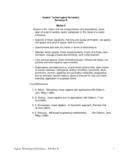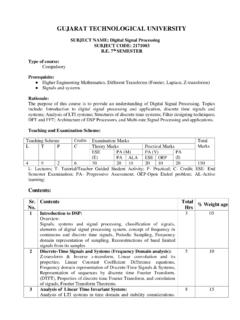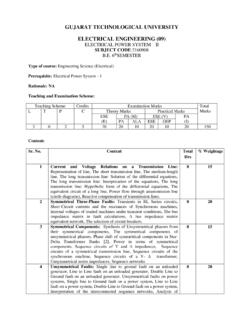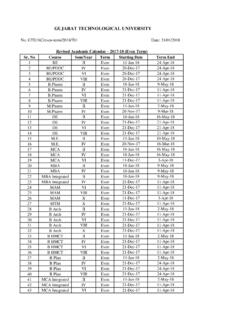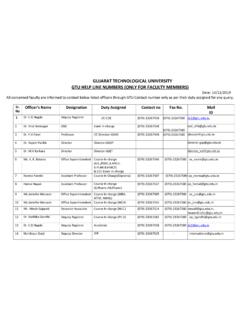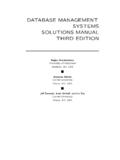Transcription of GUJARAT TECHNOLOGICAL UNIVERSITY - gtu.ac.in
1 GUJARAT TECHNOLOGICAL UNIVERSITY COMPUTER ENGINEERING (07) / INFORMATION TECHNOLOGY (16) / INFORMATION & COMMUNICATION TECHNOLOGY (32) DATABASE MANAGEMENT SYSTEMS SUBJECT CODE: 2130703 3rd Semester Type of course: Compulsory Prerequisite: (1) Elementary knowledge about computers including some experience using UNIX or Windows. (2) Computer Programming & Utilization (3) Knowledge about data structures and algorithms, corresponding to the basic course on Data Structures and Algorithms. Rationale: A database management system (DBMS) is designed to manage a large body of information.
2 Data management involves both defining structures for storing information and providing mechanisms for manipulating the information. In addition, the database system must provide for the safety of the stored information, despite system crashes or attempts at unauthorized access. If data are to be shared among several users, the system must avoid possible anomalous results due to multiple users concurrently accessing the same data. Examples of the use of database systems include airline reservation systems, company payroll and employee information systems, banking systems, credit card processing systems, and sales and order tracking systems.
3 A major purpose of a database system is to provide users with an abstract view of the data. That is, the system hides certain details of how the data are stored and maintained. Thereby, data can be stored in complex data structures that permit efficient retrieval, yet users see a simplified and easy-to-use view of the data. The lowest level of abstraction, the physical level, describes how the data are actually stored and details the data structures. The next-higher level of abstraction, the logical level, describes what data are stored, and what relationships exist among those data.
4 The highest level of abstraction, the view level, describes parts of the database that are relevant to each user; application programs used to access a database form part of the view level. Teaching and Examination Scheme: Teaching Scheme Credits Examination Marks Total Marks L T P C Theory Marks Practical Marks ESE (E) PA (M) PA (V) PA (I) PA ALA ESE OEP 4 0 4 8 70 20 10 20 10 20 150 Contents: Sr. No. Topics Teaching Hrs. Module Weightage 1 Introductory concepts of DBMS : Introduction and applications of DBMS, Purpose of data base, Data, Independence, Database System architecture- levels, Mappings, Database, users and DBA 02 05 2 relational Model : Structure of relational databases, Domains, Relations, relational algebra fundamental operators and syntax, relational algebra queries, tuple relational calculus 03 10 3 Entity-Relationship model.
5 Basic concepts, Design process, constraints, Keys, Design issues, E-R diagrams, weak entity sets, extended E-R features generalization, specialization, aggregation, reduction to E-R database schema 04 10 4 relational Database design : Functional Dependency definition, trivial and non-trivial FD, closure of FD set, closure of attributes, irreducible set of FD, Normalization 1Nf, 2NF, 3NF, Decomposition using FD- dependency preservation, BCNF, Multi- valued dependency, 4NF, Join dependency and 5NF 05 15 5 Query Processing & Query Optimization.
6 Overview, measures of query cost, selection operation, sorting, join, evaluation of expressions, transformation of relational expressions, estimating statistics of expression results, evaluation plans, materialized views 04 10 6 Transaction Management : Transaction concepts, properties of transactions, serializability of transactions, testing for serializability, System recovery, Two- Phase Commit protocol, Recovery and Atomicity, Log-based recovery, concurrent executions of transactions and related problems, Locking mechanism, solution to concurrency related problems, deadlock, , two-phase locking protocol, Isolation, Intent locking 09 20 7 Security.
7 Introduction, Discretionary access control, Mandatory Access Control, Data Encryption 02 05 8 SQL Concepts : Basics of SQL, DDL,DML,DCL, structure creation, alteration, defining constraints Primary key, foreign key, unique, not null, check, IN operator, Functions - aggregate functions, Built-in functions numeric, date, string functions, set operations, sub-queries, correlated sub-queries, Use of group by, having, order by, join and its types, Exist, Any, All , view and its types. transaction control commands Commit, Rollback, Savepoint 10 20 9 PL/SQL Concepts : Cursors, Stored Procedures, Stored Function, Database Triggers 03 05 Reference Books: 1.
8 An introduction to Database Systems, C J Date, Addition-Wesley. 2. Database System Concepts, Abraham Silberschatz, Henry F. Korth & S. Sudarshan, McGraw Hill. 3. Understanding SQL by Martin Gruber, BPB 4. SQL- PL/SQL by Ivan bayross 5. Oracle The complete reference TMH /oracle press Course Outcome: After learning the course the students should be able: 1. Evaluate business information problem and find the requirements of a problem in terms of data. 2. Understand the uses the database schema and need for normalization.
9 3. Design the database schema with the use of appropriate data types for storage of data in database. 4. Use different types of physical implementation of database 5. Use database for concurrent use. 6. Backup data from database. List of Practical: 1. To study DDL-create and DML-insert commands. (i) Create tables according to the following definition. CREATE TABLE DEPOSIT (ACTNO VARCHAR2(5) ,CNAME VARCHAR2(18) , BNAME VARCHAR2(18) , AMOUNT NUMBER(8,2) ,ADATE DATE); CREATE TABLE BRANCH(BNAME VARCHAR2(18),CITY VARCHAR2(18)); CREATE TABLE CUSTOMERS(CNAME VARCHAR2(19) ,CITY VARCHAR2(18)); CREATE TABLE BORROW(LOANNO VARCHAR2(5), CNAME VARCHAR2(18), BNAME VARCHAR2(18), AMOUNT NUMBER (8,2)); (ii) Insert the data as shown below.
10 DEPOSIT ACTNO CNAME BNAME AMOUNT ADATE 100 ANIL VRCE 1-MAR-95 101 SUNIL AJNI 4-JAN-96 102 MEHUL KAROLBAGH 17-NOV-95 104 MADHURI CHANDI 17-DEC-95 105 PRMOD 27-MAR-96 106 SANDIP ANDHERI 31-MAR-96 107 SHIVANI VIRAR 5-SEP-95 108 KRANTI NEHRU PLACE 2-JUL-95 109 MINU POWAI 10-AUG-95 BRANCH VRCE NAGPUR AJNI NAGPUR KAROLBAGH DELHI CHANDI DELHI DHARAMPETH NAGPUR BANGLORE ANDHERI BOMBAY VIRAR BOMBAY NEHRU PLACE DELHI POWAI BOMBAY CUSTOMERS ANIL CALCUTTA SUNIL DELHI MEHUL BARODA MANDAR PATNA MADHURI NAGPUR PRAMOD NAGPUR SANDIP SURAT SHIVANI BOMBAY KRANTI BOMBAY NAREN BOMBAY BORROW LOANNO CNAME BNAME AMOUNT 201 ANIL VRCE 206 MEHUL AJNI 311 SUNIL DHARAMPETH 321 MADHURI ANDHERI 375 PRMOD VIRAR 481 KRANTI NEHRU PLACE From the above given tables perform the following queries: (1) Describe deposit, branch.
